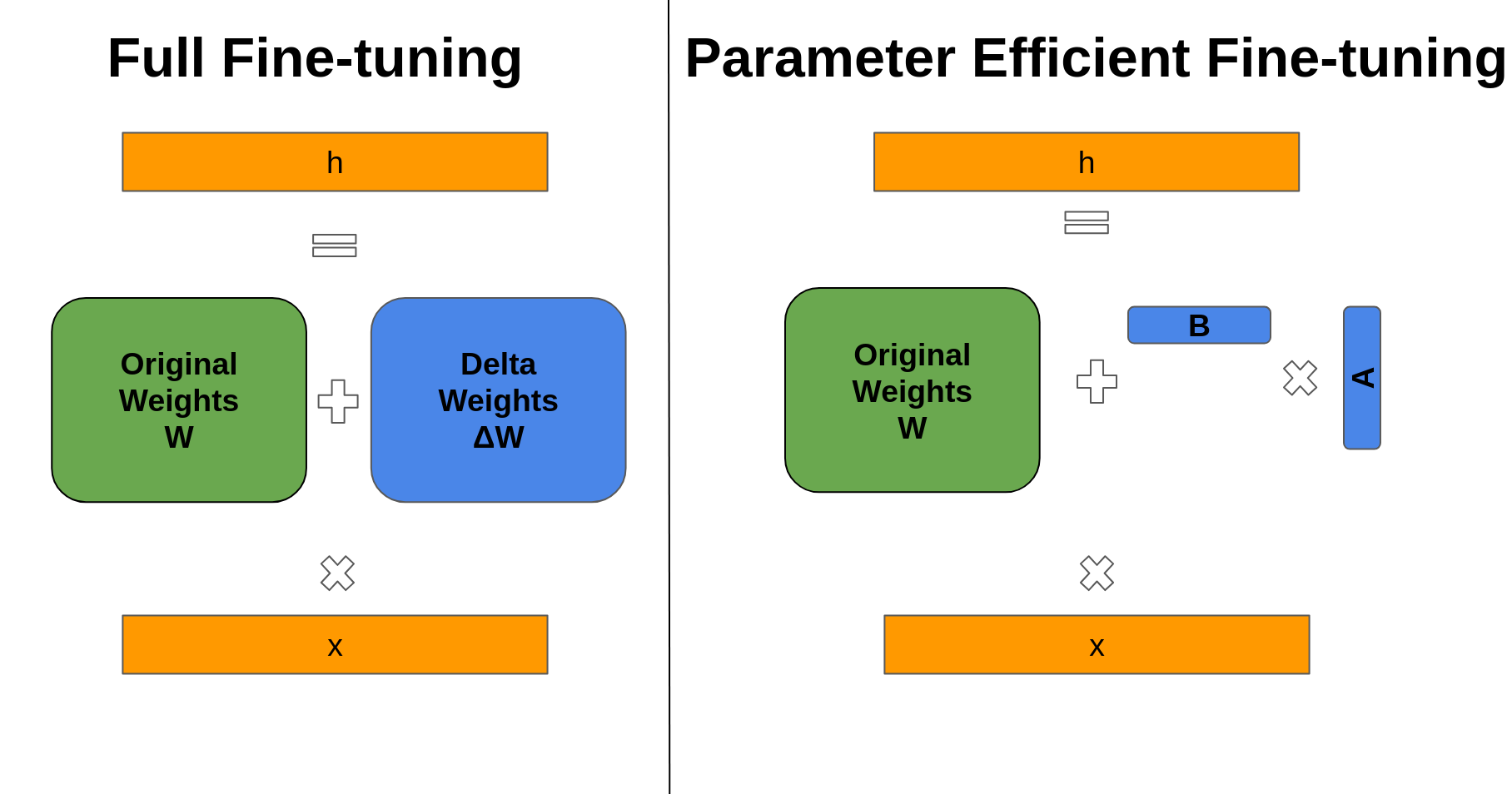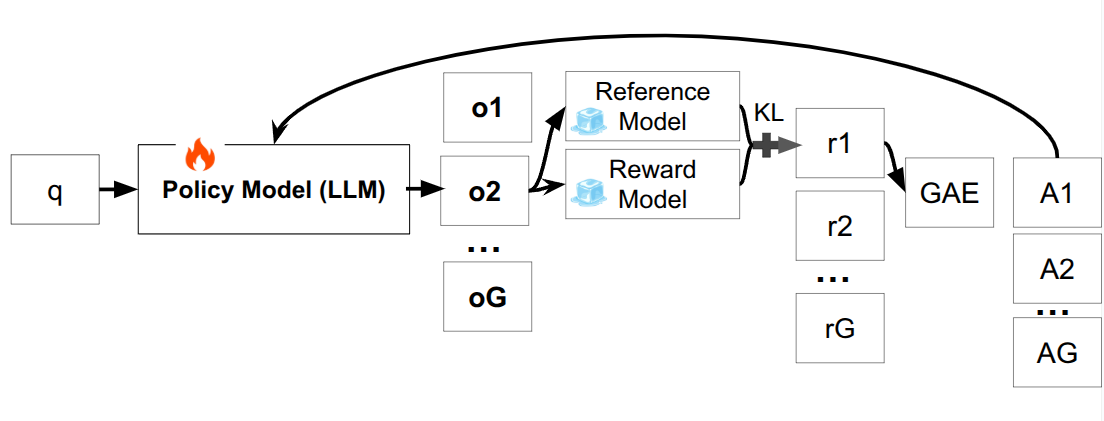
Large Language Models (LLMs) are typically trained in two broad stages: pre-training and post-training.
Pre-training is where the model learns general language understanding from massive amounts of raw, unlabeled text data (Wikipedia, books, GitHub, etc. — often exceeding 2 trillion tokens). The goal is simple: predict the next token given the previous ones. This is an unsupervised learning stage.
$$ \min_{\pi} -\log \pi(\text{I}) - \log \pi(\text{like} \mid \text{I}) - \log \pi(\text{cats} \mid \text{I like}) $$Here, the model minimizes the negative log-likelihood of each token conditioned on prior tokens — effectively learning grammar, semantics, and world knowledge.
Post-training, on the other hand, refines this general model for specific behaviors, tasks, or human-aligned objectives. It uses curated datasets and sometimes human feedback to make the model more helpful, safe, and controllable.
Supervised Fine-Tuning (SFT) is the first and simplest stage of post-training. The model is trained on a curated set of prompt–response pairs (typically 1K–1B tokens) to follow instructions and generate coherent, context-appropriate answers.
$$ \min_{\pi} -\log \pi(\text{Response} \mid \text{Prompt}) $$Only the response tokens are used for loss computation — the prompt acts as context.
SFT can be performed via:
Let $h$ be the layer output, $x$ the input, and $W$ the layer’s weight matrix. In full fine-tuning, we update the weights as:
$$ h = (W + \Delta W)x $$where $\Delta W$ is learned through gradient descent.
In parameter-efficient fine-tuning (e.g., LoRA), we decompose $\Delta W$ into low-rank matrices $A$ and $B$:
$$ h = (W + BA)x, \quad B \in \mathbb{R}^{d \times r}, \, A \in \mathbb{R}^{r \times d}. $$This reduces the number of trainable parameters from $\mathcal{O}(d^2)$ to $\mathcal{O}(2dr)$, enabling efficient training on smaller hardware.

Direct Preference Optimization (DPO) simplifies alignment by learning directly from human preference pairs — without explicitly training a reward model or performing reinforcement learning.
Given a prompt $x$, a preferred (positive) response $y_{\text{pos}}$, and a dispreferred (negative) response $y_{\text{neg}}$, DPO optimizes the following contrastive objective:
$$ \mathcal{L}_{\text{DPO}} = -\log \sigma \Big( \beta \big( \log \frac{ \pi_{\theta}(y_{\text{pos}} \mid x) }{ \pi_{\text{ref}}(y_{\text{pos}} \mid x) } - \log \frac{ \pi_{\theta}(y_{\text{neg}} \mid x) }{ \pi_{\text{ref}}(y_{\text{neg}} \mid x) } \big) \Big) $$Here:
Intuitively, DPO increases the likelihood of preferred responses relative to dispreferred ones while keeping the model close to the reference. It’s simple, stable, and effective for shaping behaviors like helpfulness, harmlessness, or multilingual capability — especially when you have human preference data.
The third and most advanced post-training stage is online reinforcement learning, often referred to as Reinforcement Learning from Human Feedback (RLHF). Here, the model interacts with a reward signal to learn optimal responses.
This process typically involves 1K–10M prompts, depending on the task and resources.
Given a batch of prompts, the model generates one or more candidate responses. A reward function then scores each response.
Two main policy optimization methods are used in RLHF for LLMs:
Given a query $q$, a policy model (LLM) generates a response $o$. Three models interact during PPO:
The advantage $A_t$ is computed using Generalized Advantage Estimation (GAE) to quantify how much better each token’s action was compared to expectation.

The PPO objective is:
$$ \mathcal{J}_{\text{PPO}}(\theta) = \mathbb{E}_{q \sim P(Q),\, o \sim \pi_{\theta_{\text{old}}}(O \mid q)} \Bigg[ \frac{1}{|o|} \sum_{t=1}^{|o|} \min\!\Bigg( \frac{ \pi_{\theta}(o_t \mid q, o_{\lt t}) }{ \pi_{\theta_{\text{old}}}(o_t \mid q, o_{\lt t}) } A_t, \text{clip}\!\Bigg( \frac{ \pi_{\theta}(o_t \mid q, o_{\lt t}) }{ \pi_{\theta_{\text{old}}}(o_t \mid q, o_{\lt t}) }, 1 - \epsilon, 1 + \epsilon \Bigg) A_t \Bigg) \Bigg] $$Maximizing this objective encourages responses with higher rewards while maintaining stability through clipping and KL regularization.
GRPO modifies PPO by changing how advantages are calculated. Instead of using a value model, it generates multiple responses $o_1, \ldots, o_G$ for each query and computes group-level relative rewards. The advantage for each response is derived by comparing its reward to others in the group.
This removes the need for a separate value model, resulting in:

However, GRPO relies on having multiple responses per prompt, making it less suitable when only one response can be sampled.
Post-training is where general-purpose LLMs become usable assistants.
Together, these methods bridge the gap between raw pre-trained models and helpful, safe, and aligned AI systems.